全向移动小车-----本科毕业论文
本科毕业设计__全方位移动爬楼梯机器人小车的研究开题报告

分类号________密级________UDC________编号________江西理工大学开题报告论文题名全方位移动爬楼梯机器人小车的研究申请学位级别___工学硕士____专业名称机械电子工程__毕业设计(论文)原创性声明和使用授权说明原创性声明本人郑重承诺:所呈交的毕业设计(论文),是我个人在指导教师的指导下进行的研究工作及取得的成果。
尽我所知,除文中特别加以标注和致谢的地方外,不包含其他人或组织已经发表或公布过的研究成果,也不包含我为获得及其它教育机构的学位或学历而使用过的材料。
对本研究提供过帮助和做出过贡献的个人或集体,均已在文中作了明确的说明并表示了谢意。
作者签名:日期:指导教师签名:日期:使用授权说明本人完全了解大学关于收集、保存、使用毕业设计(论文)的规定,即:按照学校要求提交毕业设计(论文)的印刷本和电子版本;学校有权保存毕业设计(论文)的印刷本和电子版,并提供目录检索与阅览服务;学校可以采用影印、缩印、数字化或其它复制手段保存论文;在不以赢利为目的前提下,学校可以公布论文的部分或全部内容。
作者签名:日期:学位论文原创性声明本人郑重声明:所呈交的论文是本人在导师的指导下独立进行研究所取得的研究成果。
除了文中特别加以标注引用的内容外,本论文不包含任何其他个人或集体已经发表或撰写的成果作品。
对本文的研究做出重要贡献的个人和集体,均已在文中以明确方式标明。
本人完全意识到本声明的法律后果由本人承担。
作者签名:日期:年月日学位论文版权使用授权书本学位论文作者完全了解学校有关保留、使用学位论文的规定,同意学校保留并向国家有关部门或机构送交论文的复印件和电子版,允许论文被查阅和借阅。
本人授权大学可以将本学位论文的全部或部分内容编入有关数据库进行检索,可以采用影印、缩印或扫描等复制手段保存和汇编本学位论文。
涉密论文按学校规定处理。
作者签名:日期:年月日导师签名:日期:年月日指导教师评阅书评阅教师评阅书教研室(或答辩小组)及教学系意见目录一、课题意义 (2)(一)具有越障功能移动机器人的简介 (2)(二) 具有越障功能机器人研究的文献综述 (4)二、课题方案 (8)(一)课题研究的主要内容 (8)(二)研究目标及创新 (10)三、可行性分析 (10)四、课题进度安排 (12)五、参考文献 (12)一、课题意义(一)具有越障功能移动机器人的简介机器人作为一种自动化的机器,所不同的是这种机器具备一些与人或生物相似的智能能力,如感知能力、规划能力、动作能力和协同能力,是一种具有高度灵活性的自动化机器。
自动搬运小车毕业设计

自动搬运小车毕业设计【毕业设计题目】:基于自动化技术的搬运小车设计与实现【摘要】:本毕业设计基于自动化技术,设计并实现一种自动搬运小车,旨在解决人力搬运过程中的繁琐和劳动强度问题。
该小车将具备自动导航、定位、搬运等功能,通过控制系统实现智能化操控,大幅提高工作效率和操作便捷性。
设计过程中将采用模块化和可编程的方法,以方便扩展和改进。
【关键词】:自动化技术、搬运小车、自动导航、定位、模块化、可编程【引言】:随着科技的发展,自动化技术的广泛应用改变了许多传统工作方式。
搬运工作作为生产和物流过程中不可或缺的一环,其劳动强度和操作效率对企业运作至关重要。
本毕业设计旨在设计并实现一种自动搬运小车,通过引入自动导航和定位技术,提高小车的智能化水平,减少人工干预和劳动强度,从而达到提高工作效率和操作便捷性的目的。
【设计目标】:1. 实现小车的自动导航和定位功能,能够按照设定的路径自主行驶,避免碰撞和危险区域;2. 设计一个搬运装置,能够根据需求搬运货物,并具备自动装卸功能;3. 开发一个可编程的控制系统,能够对小车进行远程控制和指令调整,方便操作和管理;4. 设计小车的电力系统,实现长时间的工作并能够自主充电或充电桩充电;5. 模块化设计,方便对小车的功能进行扩展和改进。
【设计方法】:1. 硬件设计:选择适用的电机、传感器和执行器,设计和制造搬运装置,以及构建稳定的底盘结构;2. 软件设计:使用嵌入式系统和编程语言开发控制系统,实现自动导航和定位功能;3. 系统集成:将硬件和软件进行集成,测试系统的稳定性和性能;4. 调试和优化:反复测试并根据实际情况进行参数调优,提高小车的性能和可靠性。
【预期成果】:1. 自动搬运小车的硬件设计和制造;2. 小车自动导航和定位的软件开发和调试;3. 功能完善、稳定可靠的自动搬运小车原型;4. 设计文档和使用说明书;5. 毕业论文和答辩材料。
【创新点】:1. 引入自动导航和定位技术,实现小车的智能化行驶和定位功能;2. 设计可编程的控制系统,方便远程操控和指令调整;3. 搬运装置具备自动装卸功能,提高小车的搬运效率;4. 模块化设计,方便后续功能扩展和改进。
多功能智能小车设计毕业设计(论文)
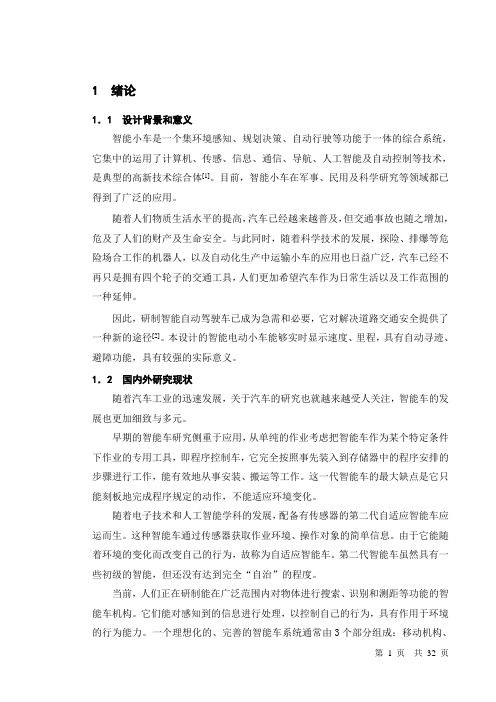
1 绪论1.1 设计背景和意义智能小车是一个集环境感知、规划决策、自动行驶等功能于一体的综合系统,它集中的运用了计算机、传感、信息、通信、导航、人工智能及自动控制等技术,是典型的高新技术综合体[1]。
目前,智能小车在军事、民用及科学研究等领域都已得到了广泛的应用。
随着人们物质生活水平的提高,汽车已经越来越普及,但交通事故也随之增加,危及了人们的财产及生命安全。
与此同时,随着科学技术的发展,探险、排爆等危险场合工作的机器人,以及自动化生产中运输小车的应用也日益广泛,汽车已经不再只是拥有四个轮子的交通工具,人们更加希望汽车作为日常生活以及工作范围的一种延伸。
因此,研制智能自动驾驶车已成为急需和必要,它对解决道路交通安全提供了一种新的途径[2]。
本设计的智能电动小车能够实时显示速度、里程,具有自动寻迹、避障功能,具有较强的实际意义。
1.2 国内外研究现状随着汽车工业的迅速发展,关于汽车的研究也就越来越受人关注,智能车的发展也更加细致与多元。
早期的智能车研究侧重于应用,从单纯的作业考虑把智能车作为某个特定条件下作业的专用工具,即程序控制车,它完全按照事先装入到存储器中的程序安排的步骤进行工作,能有效地从事安装、搬运等工作。
这一代智能车的最大缺点是它只能刻板地完成程序规定的动作,不能适应环境变化。
随着电子技术和人工智能学科的发展,配备有传感器的第二代自适应智能车应运而生。
这种智能车通过传感器获取作业环境、操作对象的简单信息。
由于它能随着环境的变化而改变自己的行为,故称为自适应智能车。
第二代智能车虽然具有一些初级的智能,但还没有达到完全“自治”的程度。
当前,人们正在研制能在广泛范围内对物体进行搜索、识别和测距等功能的智能车机构。
它们能对感知到的信息进行处理,以控制自己的行为,具有作用于环境的行为能力。
一个理想化的、完善的智能车系统通常由3个部分组成:移动机构、感知系统和控制系统[3]。
目前研制的智能车虽大都只具有部分智能,但也已在很多领域得到了广泛的应用。
毕业设计-可遥控搬运小车设计

毕业论文(设计)题系专学可遥控搬运小车设计—硬件设计学生指导教师【摘要】本设计是以现代物流仓储为背景,主要分为两大部分,可遥控搬运小车和控制终端。
搬运小车采用STC89C52RC单片机作为主控制器,小车上装有光电传感器、基于Zigbee的无线通信模块、2自由度的机械臂。
光电传感器用以检测地面上的黑带;无线通信模块用以接受控制终端发送的控制指令;机械臂用以抓取地面货物。
控制终端采用STC89C52RC单片机作为主控制器,包括基于Zigbee的无线通信模块、条形码扫描枪、12864液晶显示器和按键。
通信模块用以发送控制指令到小车;扫描枪用以读取货物上的条形码信息;12864用以显示条形码等相关信息;按键用以手动输入小车的控制指令。
通过本系统可实现现代仓储的智能化和真正的无人职守。
【关键词】仓储智能搬运Zigbee 机械臂无线通信The Design of Remote Control handling car-software design【Abstract】the background of this design is based on modern logistics and storage, are divided into two parts, remote handling car and control Terminal. Handling car with the stc89c52rc single - chip computer as the primary controller, Dolly is equipped with electro - optical sensors, based on ZigBee wireless communications module, 2 - DOF robotic arm. Black belt on the photoelectric sensor used to detect ground ; wireless communication module to accept control commands sent control terminal ; mechanical arm to grab goods on the ground. Control terminals with the stc89c52rc single - chip computer as the primary controller, including based on ZigBee wireless communications module, barcode scanner, 12,864 LCD display and press the key. Communication module is used to send control commands to the car ; scanner used to read information on the goods barcode ; 12,864 related information such as to display the barcode ; keys to manually enter the car's control instructions. Modern warehouse is achieved by this system of intelligent and really no one of his or her duties.【Keywords】Storage intelligent handling ZigBee manipulator wireless communication目录1 绪论 (1)1.1 背景 (1)1.2 现状与发展 (1)1.3 论文主要工作 (2)2 方案论证 (2)2.1循迹模块方案论证 (3)2.1.1 1个传感器方案 (3)2.1.2 2个传感器方案 (3)2.1.3 3个传感器方案 (3)2.1.4 5个传感器方案 (4)2.2 电源模块方案论证 (4)2.2.1 LM7812稳压模块 (4)2.2.2 LM1085稳压模块 (5)2.3 光电对管后级电路方案论证 (5)2.3.1 三极管方案 (5)2.3.2 集成比较器方案 (6)2.4 电压比较器方案论证 (6)2.4.1 迟滞电压比较器 (6)2.4.2 窗口电压比较器 (7)2.4.3 单限电压比较器 (7)3 理论分析与计算 (8)3.1 电压比较器参考电压计算 (8)3.2 LM1085参考电阻计算 (9)4 硬件设计 (10)4.1 小车硬件设计 (11)4.1.1 单片机最小系统 (11)4.1.2 电源稳压电路 (12)4.1.3 循迹电路 (13)4.1.4 电机驱动电路 (14)4.2 控制终端硬件设计 (15)4.2.1 电源稳压电路 (15)4.2.2 单片机最小系统 (15)4.2.3 按键电路 (15)4.2.4 12864液晶屏接口电路 (15)5 软件设计 (16)5.1 小车软件设计 (16)5.1.1小车软件框架 (16)5.1.2 小车循迹程序 (17)5.1.3 机械臂程序 (19)5.2 控制终端软件设计 (19)5.2.1 主流程 (19)6 系统测试 (20)6.1 测试仪器 (20)6.2 单片机PWM测试 (20)6.3 光电传感器测试 (21)6.4 可调电源测试 (21)7总结以及展望 (22)致谢 (22)参考文献 (23)1 绪论随着社会水平的提高,仓储业已发展成为一个相对独立的行业,现在有很多发展中仓库,面积可达上万平方米,大型货物配送中心发展迅猛,使传统的仓储功能发生了质的变化。
智能小车本科毕业论文

随着社会各行各业的迅速发展,根据人类的需求出现了各种各样的智能机器人、智能车。
智能小车又称为移动式机器人,是一个多种高新技术的集成体,它融合了机械、电子、传感器、计算机硬件、软件、人工智能等许多学科的知识,伴着我国科学技术的进步,智能化和自动化技术越来越普及,各种高科技也广泛应用于智能车等制造领域,使智能车越来越多样化。
根据不同的需求便出现了各种功能的智能小车。
本设计是以AT89C52单片机为核心的智能车的设计,系统主要由红外检测模块、单片机最小系统模块、电机控制模块、电源模块组成。
其中电源模块由四节1.5V电池组成,经过7805稳压电路输出5V的稳定电压;红外检测模块包括两只红外反射式对管TCRT5000;最小系统模块主要包括AT89C52单片机和其外围电路;电机模块包括两个减速直流电机及其附属减速箱和两个电机驱动控制芯片L298N。
软件部分由C语言编程,实现对各部分的处理和控制。
该智能车可以实现自动避障、避障的功能。
整个系统结构简单,运行高效。
关键词:智能小车避障 AT89C52 L298N电机驱动With the rapid development of all sectors of society, based on human needs emergence of a variety of intelligent robots, intelligent vehicles. Smart car, also known as mobile robots, is a multi-tech integrated body, which combines mechanical, electronics, sensors, computer hardware, software, artificial intelligence, and many other disciplines of knowledge, accompanied by China's scientific and technological progress, intelligent and automation technology is becoming increasingly popular, is also widely used in various high-tech smart car and other manufacturing fields, make the smart car more and more diverse. Depending on the needs of the various functions will appear smart car.The design is based on AT89C52 microcontroller as the core of the intelligent vehicle design, the system mainly consists of infrared detection module, the smallest single-chip system module, motor control module, power module. Wherein the power supply module consists of four 1.5V batteries composed after 7805 5V regulator circuit output stable voltage; infrared detector module includes two infrared reflective of the tube TCRT5000; minimum system module includes AT89C52 microcontroller and its peripheral circuits; motor module includes two DC motors and its subsidiary reducer gearbox and two motor drive control chip L298N. Software part by the C programming language, to achieve the various parts of the processing and control. The smart car can automatically avoid obstacles, obstacle avoidance function. The whole system is simple, efficient operation.Key words:Intelligent car Obstacle avoidance Remote control AT89C52目录目录 (i)前言 (1)1绪论 (2)1.1 智能小车的研究现状及发展趋势 (2)1.1.1 智能小车的研究现状 (2)1.1.2 智能小车的发展趋势 (2)1.2 本文的结构 (3)2 系统总体方案设计 (5)2.1 系统各部分设计方案 (5)2.1.1 单片机型号的选定 (5)2.1.2 直流电机驱动芯片的选定 (6)2.1.3 红外对管的选定 (8)2.2 总体方案设计 (9)2.3 智能小车的基本介绍 (9)2.3.1 智能小车的基本结构 (10)2.3.2智能小车的基本功能及原理 (10)3硬件设计 (11)3.1系统硬件结构图 (11)3.2 单片机主控单元的设计 (11)3.2.1 单片机引脚说明 (11)3.2.2 AT89C52最小系统设计 (16)3.3红外检测单元设计 (17)3.4 电机驱动单元设计 (21)3.5 系统总体原理图 (22)3.6 硬件抗干扰设计 (23)3.6.1 电源干扰的抑制 (23)3.6.2 信号通道干扰的抑制 (23)4系统软件设计 (25)4.1主程序设计 (26)4.2 红外检测模块程序设计 (27)4.3 电机驱动模块程序设计 (28)4.4 系统软件抗干扰设计 (29)5系统仿真 (31)5.1系统在proteus的仿真 (31)5.2仿真总结与问题补充 (31)5.2.1仿真总结 (32)5.2.2问题补充 (32)结论 (33)致谢................................................................................ 错误!未定义书签。
智能小车毕业论文
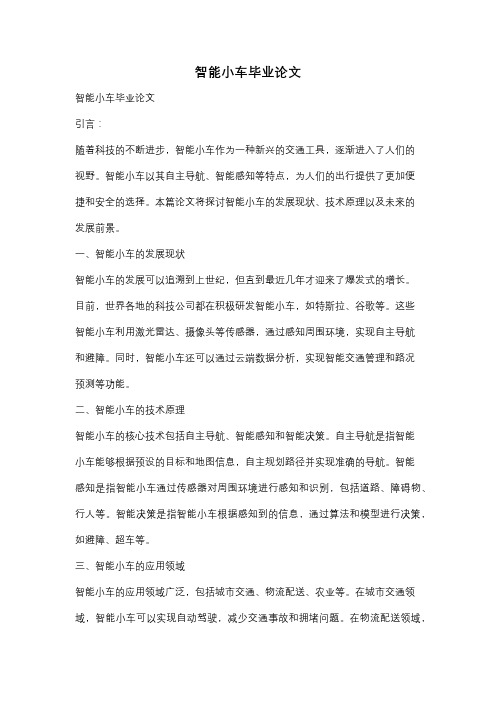
智能小车毕业论文智能小车毕业论文引言:随着科技的不断进步,智能小车作为一种新兴的交通工具,逐渐进入了人们的视野。
智能小车以其自主导航、智能感知等特点,为人们的出行提供了更加便捷和安全的选择。
本篇论文将探讨智能小车的发展现状、技术原理以及未来的发展前景。
一、智能小车的发展现状智能小车的发展可以追溯到上世纪,但直到最近几年才迎来了爆发式的增长。
目前,世界各地的科技公司都在积极研发智能小车,如特斯拉、谷歌等。
这些智能小车利用激光雷达、摄像头等传感器,通过感知周围环境,实现自主导航和避障。
同时,智能小车还可以通过云端数据分析,实现智能交通管理和路况预测等功能。
二、智能小车的技术原理智能小车的核心技术包括自主导航、智能感知和智能决策。
自主导航是指智能小车能够根据预设的目标和地图信息,自主规划路径并实现准确的导航。
智能感知是指智能小车通过传感器对周围环境进行感知和识别,包括道路、障碍物、行人等。
智能决策是指智能小车根据感知到的信息,通过算法和模型进行决策,如避障、超车等。
三、智能小车的应用领域智能小车的应用领域广泛,包括城市交通、物流配送、农业等。
在城市交通领域,智能小车可以实现自动驾驶,减少交通事故和拥堵问题。
在物流配送领域,智能小车可以实现自动化的货物运输,提高效率和准确性。
在农业领域,智能小车可以用于农田的巡视和作物的采摘,提高农业生产的效益。
四、智能小车的挑战和未来发展虽然智能小车在技术上取得了一定的突破,但仍然面临着一些挑战。
首先是安全性问题,智能小车在自主导航和避障等方面仍有待提高,需要进一步优化算法和传感器技术。
其次是法律和道德问题,智能小车的出现引发了一系列的法律和道德争议,如自动驾驶时的责任问题等。
未来,智能小车的发展需要政府、企业和学术界的共同努力,加强技术研发和法律法规的制定。
结论:智能小车作为一种新兴的交通工具,具有巨大的发展潜力。
通过自主导航、智能感知和智能决策等技术,智能小车可以为人们的出行提供更加便捷和安全的选择。
智能小车优秀毕业论文
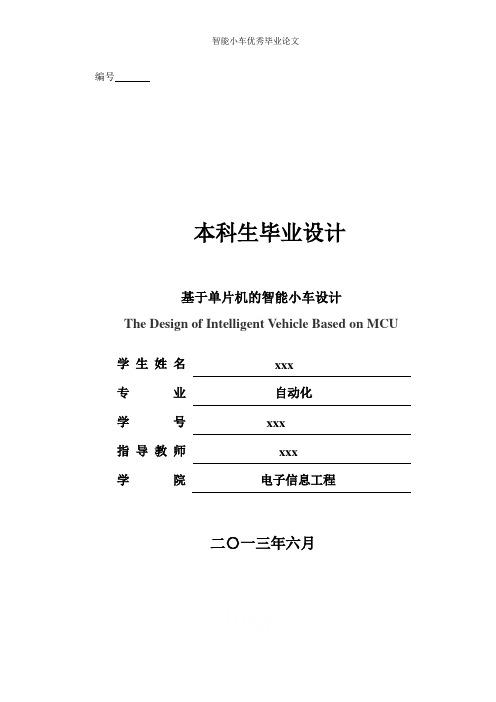
智能小车优秀毕业论文编号本科生毕业设计基于单片机的智能小车设计The Design of Intelligent Vehicle Based on MCU 学生姓名xxx专业自动化学号xxx指导教师xxx学院电子信息工程二〇一三年六月毕业设计原创承诺书1.本人承诺:所呈交的毕业设计(论文)《基于单片机的智能小车设计》,是认真学习理解学校的《长春理工大学本科毕业设计(论文)工作条例》后,在教师的指导下,保质保量独立地完成了任务书中规定的内容,不弄虚作假,不抄袭别人的工作内容。
2.本人在毕业设计(论文)中引用他人的观点和研究成果,均在文中加以注释或以参考文献形式列出,对本文的研究工作做出重要贡献的个人和集体均已在文中注明。
3.在毕业设计(论文)中对侵犯任何方面知识产权的行为,由本人承担相应的法律责任。
4.本人完全了解学校关于保存、使用毕业设计(论文)的规定,即:按照学校要求提交论文和相关材料的印刷本和电子版本;同意学校保留毕业设计(论文)的复印件和电子版本,允许被查阅和借阅;学校可以采用影印、缩印或其他复制手段保存毕业设计(论文),可以公布其中的全部或部分内容。
以上承诺的法律结果将完全由本人承担!作者签名:• 年•• 月• 日摘要随着我国高科技水平的不断提高和工业自动化进程的不断推进,智能车被广泛应用于各种玩具和其他产品的设计中,极大地丰富了人们的生活。
本文基于ATmega16 单片机设计了一种智能循迹避障小车,由电源模块、红外传感器模块、电机驱动模块、调试模块和MCU模块组成。
利用红外对管和超声波检测黑线与障碍物,当左边的红外对管检测到黑线时,小车往左边偏转,右边的红外对管检测到黑线时,小车往右边偏转。
以ATmega16单片机为控制芯片控制电动小车的速度及转向,从而实现自动循迹避障的功能。
其中小车驱动由L298N驱动电路完成,速度由单片机控制。
关键词:智能小车单片机自动循迹避障AbstractWith the increasing levels of high-tech and industrial automation process progresses, the intelligent vehicle is widely used to all kinds of toys and another production’s devise. It is greatly enriched the life of the people.Based on ATmega16 microcontroller,this paper is about a design of intelligent tracking-avoidance car, which is consist of the power supply module, infrared sensor module, the motor drive module, debug module and the MCU modules. Using infrared and ultrasonic testing on the tube black line and the obstacle, when left on the tube detects infrared black line, the car deflected to the left, the right of infrared tube black line is detected, the car to the right deflection. ATmega16 microcontroller for the control chip to control the speed and steering electric car, enabling automatic tracking avoidance function. Which car is driven by L298N driver circuit completed, the speed controlled by the MCU.Keywords: Intelligent Vehicle; MCU;automatic tracking; obstacle avoidance目录摘要 (I)ABSTRACT (II)目录 (III)第1章绪论 (1)1.1引言 (1)1.2课题研究目的及意义 (1)1.3课题研究现状及发展趋势 (2)1.4本文的主要工作 (3)第2章小车的总体方案设计 (4)2.1设计思路 (4)2.2小车循迹避障传感器的选型 (6)2.3小车循迹避障设计方案 (8)第3章小车的硬件电路设计 (10)3.1单片机的选型 (10)3.2小车的硬件电路设计 (14)第4章小车的软件设计 (19)4.1主程序设计及流程图 (19)4.2避障子程序设计及流程图 (20)4.3循迹子程序设计及流程图 (21)结论 (22)参考文献 (23)致谢 (24)附录1 系统电路图 (24)附录2 智能循迹壁障小车完整程序 (27)第1章绪论1.1引言智能,在科技高速发展的今天,已成为一个引领时尚前沿的代名词,智能手机,智能机器人等等已经在工业,军事中得到广泛的作用,在不为人们所熟知的领域,如深海探测,航空航天,地质勘探,智能也发挥着举足轻重的作用[1]。
自动往返电动小汽车(毕业设计)

一. 毕业实践任务书无锡职业技术学院毕业实践任务书课题名称:自动往返电动小汽车指导教师:XXXXXXX 职称:讲师指导教师:职称:专业名称:XXXXXXXX 班组:XXXXXX学生姓名:XXXXXXX 学号:05一. 课题需要完成的任务:设计并制作一个能自动往返于起跑线与终点线间的小汽车。
允许用玩具汽车改装,但不能用人工遥控(包括有线和无线遥控)。
图1跑道顶视图跑道宽度0.5m,表面贴有白纸,两侧有挡板,挡板与地面垂直,其高度不低于20cm。
在跑道的B、C、D、E、F、G各点处画有2cm宽的黑线,各段的长度如图1所示。
设计要求1、车辆从起跑线出发(出发前,车体不得超出起跑线),到达终点线后停留10秒,然后自动返回起跑线(允许倒车返回)。
往返一次的时间应力求最短(从合上汽车电源开关开始计时)。
2. 达终点线和返回起跑线时,停车位置离起跑线和终点线偏差应最小(以车辆中心点与终点线或起跑线中心线之间距离作为偏差的测量值)。
D~E间为限速区,车辆往返均要求以低速通过,通过时间不得少于8秒,但不允许在限速区内停车。
二. 课题计划:2006.3.3~2006.3.6 熟悉课题,可行性方案分析及方案论述。
2006.3.7~2006.3.19 查阅资料,设计各部分硬件。
2006.3.19~2006.4.10 画原理图,印刷线路板。
2006.4.10~2006.4.20 编写程序验证部分硬件。
2006.4.21~2006.4.25 写出毕业论文。
计划答辩时间:4.21-4.28XXXXX 系(部、分院)2006年02年18日二.外文翻译VIDEOCASSETTEBefore the videocassette recorder there was the movie projector and screen. Perhaps you remember your fifth-grade teacher pulling down a screen—or Dad hanging a sheet on the wall, ready to show visiting friends the enthralling account of your summer vacation at the shore. Just as the film got started, the projector bulb often blew out.Those days did have one advantage, though: the screen was light, paper-thin and could be rolled into a portable tube. Compare that with bulky television and computer screens, and the projector screen invokes more than just nostalgia. Could yesterday's convenience be married to today's technology?The answer is yes, thanks to organic light-emitting materials that promise to make electronic viewing more convenient and ubiquitous. Used in displays, the organic materials are brighter, consume less energy and are easier to manufacture (thus potentially cheaper) than current options based on liquid crystals. Because organic light-emitting diodes (OLEDs) emit light, they consume significantly less power, especially in small sizes, than common liquid-crystal displays (LCDs), which require backlighting. OLEDs also offer several exciting advantages over common LEDs: the materials do not need to be crystalline (that is, composed of a precisely repeating pattern of planes of atoms), so they are easier to make; they are applied in thin layers for a slimmer profile; and different materials (for different colors) can be patterned on a given substrate to make high-resolution images. The substrates may be inexpensive glass or flexible plastic or even metal foil.In the coming years, large-screen televisions and computer monitors could roll up for storage. A soldier might unfurl a sheet of plastic showing a real-time situation map. Smaller displays could be wrapped around a person's forearm or incorporated into clothing. Used in lighting fixtures, the panels could curl around an architectural column or lie almost wallpaperlike against a wall or ceiling.LEDs currently have longer lifetimes than organic emitters, and itwill be tough to beat the widespread LED for use in indicator lamps. But OLEDs are already demonstrating their potential for displays. Their screens put out more than 100 candelas per square meter (about the luminance of a notebook screen) and last tens of thousands of hours (several years of regular use) before they dim to half their original radiance.Close to 100 companies are developing applications for the technology, focusing on small, low-power displays [see box on page 80]. Initial products include a nonflexible 2.2-inch (diagonal) display for digital cameras and cellular phones made jointly by Kodak and Sanyo, introduced in 2002, and a 15-inch prototype computer monitor produced by the same collaborative venture. The global market for organic display devices was about $219 million in 2003 and is projected to jump to $3.1 billion by 2009, according to Kimberly Allen of iSuppli/Stanford Resources, a market-research firm specializing in displays.一、What LED to OLEDCRYSTALLINE semiconductors—the forerunners of OLEDs—trace their roots back to the development of the transistor in 1947, and visible-light LEDs were invented in 1962 by Nick Holonyak, Jr. They were first used commercially as tiny sources of red light in calculators and watches and soon after also appeared as durable indicator lights of red, green or yellow. (When suitably constructed, LEDs form lasers, which have spawned the optical-fiber revolution, as well as optical data storage on compact discs and digital video discs.) Since the advent of the blue LED in the 1990s [see “Blue Chip,” by Glenn Zorpette; Scientific American, August 2000], full-color, large-screen television displays made from hundreds of thousands of LED chips have appeared in spectacular fashion on skyscrapers and in arenas [see “In Pursuit of the Ultimate Lamp,” by M. George Crawford, Nick Holonyak, Jr., and Frederick A. Kish, Jr.; Scientific American, February 2001]. Yet the smaller sizes used in devices such as PDAs (personal digital assistants) and laptops are not as practical.LEDs and OLEDs are made from layers of semiconductors—materials whose electrical performance is midway between an excellent conductorsuch as copper and an insulator such as rubber. Semiconducting materials, such as silicon, have a small energy gap between electrons that are bound and those that are free to move around and conduct electricity. Given sufficient energy in the form of an applied voltage, electrons can “jump” the gap a nd begin moving, constituting an electrical charge. A semiconductor can be made conductive by doping it; if the atoms added to a layer have a smaller number of electrons than the atoms they replace, electrons have effectively been removed, leaving positively charged “holes” and making the material “p-type.” Alternatively, a layer that is doped so that it has an excess of negatively charged electrons becomes “n-type” [see box on opposite page]. When an electron is added to a p-type material, it may encounter a hole and drop into the lower band, giving up an amount of energy (equal to the energy gap) as a photon of light. The wavelength depends on the energy gap of the emitting material.For the production of visible light, organic materials should have an energy gap between their lower and higher conduction bands in a relatively small range, about two to three electron volts. (One electron volt is defined as the kinetic energy gained by an electron when it is accelerated by a potential difference of one volt. A photon with one electron volt of energy corresponds to the infrared wavelength of 1,240 nanometers, and a photon of two electron volts has a wavelength half as much—620 nanometers—a reddish color.)二、A Surprising GlowORGANIC semiconductors are formed as aggregates of molecules that are, in the technologies being pursued, amorphous—a solid material, but one that is noncrystalline and without a definite order. There are two general types of organic light emitters, distinguished by “small” and “large” molecule sizes. The first practical p-n-type organic LED, based on small molecules, was invented in 1987 by Ching W. Tang and Steven A. Van Slyke of Eastman Kodak, after Tang noticed a surprising green glow coming from an organic solar cell he was working on. The duo recognized that by using two organic materials, one a good conductor of holes and the other a good conductor of electrons, they could ensure that photon emission would take place near the contact area, or junction, of the two materials, as in acrystalline LED. They also needed a material that held its electrons tightly, meaning that it would be easy to inject holes. For the light to escape, one of the contacts must be transparent, and the scientists benefited from the fortunate fact that the most widely used transparent conducting material, indium tin oxide, bound its electrons suitably for p-type contact material.The structure they came up with has not changed much over the years and is often called “Kodak-type,” because Kodak had the basic patent [see box on opposite page]. Beginning with a glass substrate, different materials are deposited layer by layer. This process is accomplished by evaporating the constituent materials and letting them condense on the substrate. The total thickness of the organic layers is only 100 to 150 nanometers, much thinner than that of a conventional LED (which is at least microns in thickness) and less than 1 percent of the thickness of a human hair. Because the molecules of the materials used are relatively lightweight—even lighter than a small protein—the Kodak-type OLEDs are referred to as “small molecule” OLEDs.After their initial insight, Tang and Van Slyke tinkered with the design to increase efficiency. They added a small amount of the fluorescent dye coumarin to the emitter material tris (8-hydroxy-quinoline) aluminum. The energy released by the recombination of holes and electrons was transferred to the dye, which emitted light with greatly increased efficiency. Deposition of additional thin layers of indium tin oxide and other compounds next to the electrodes altered the interaction of the thicker layers and also improved the efficiency of the injection of holes and electrons, thereby further upping the overall power efficiency of the fluorescent OLED.Organic LEDs of this small-molecule type are used to make red, green and blue light, with green light having the highest efficiency. Such green-emitting OLEDs can exhibit luminous efficiencies of 10 to 15 candelas per ampere—about as efficient as commercial LEDs today—and seven to 10 lumens per watt, values that are comparable to those for common incandescent lamps.录像机在卡匣式录像机出来之前,我们用的是电影放映机与屏幕。
大学本科机械专业机械手行走小车毕业设计
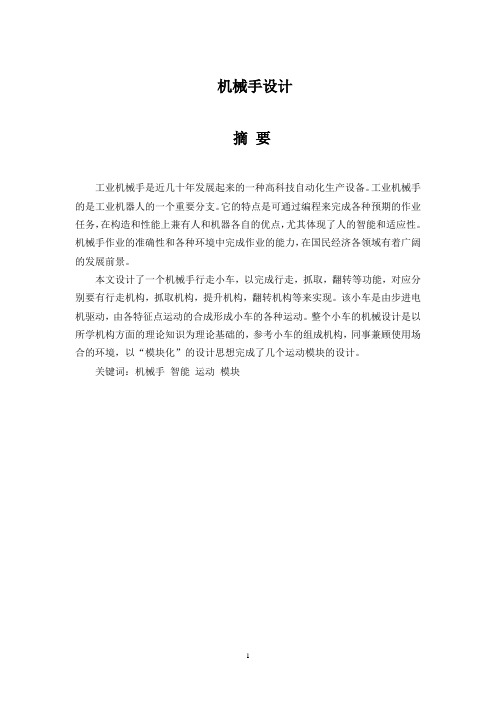
机械手设计摘要工业机械手是近几十年发展起来的一种高科技自动化生产设备。
工业机械手的是工业机器人的一个重要分支。
它的特点是可通过编程来完成各种预期的作业任务,在构造和性能上兼有人和机器各自的优点,尤其体现了人的智能和适应性。
机械手作业的准确性和各种环境中完成作业的能力,在国民经济各领域有着广阔的发展前景。
本文设计了一个机械手行走小车,以完成行走,抓取,翻转等功能,对应分别要有行走机构,抓取机构,提升机构,翻转机构等来实现。
该小车是由步进电机驱动,由各特征点运动的合成形成小车的各种运动。
整个小车的机械设计是以所学机构方面的理论知识为理论基础的,参考小车的组成机构,同事兼顾使用场合的环境,以“模块化”的设计思想完成了几个运动模块的设计。
关键词:机械手智能运动模块引言0.1机械手简介 (1)0.2机械手的组成 (3)0.3 应用机械手的意义 (5)第一章总体技术方案及系统组成1.1原始数据 (7)1.2 工作要求 (7)1.3系统组成 (8)1.4总体技术方案 (8)第二章机械手的液压部分2.1液压系统的工作原理 (10)2.2液压传动的工作特征 (10)2.3液压系统的组成 (10)2.4液压系统的优、缺点 (11)第三章回转装置的总体组成及结构设计3.1 回转装置的组成 (13)第四章机械传动方案的设计与计算4.1 小车的主要组成部分 (15)4.2 同步带传动方式优缺点 (15)4.3 驱动动力源 (15)4.4 机械传动方案的设计计算 (16)第五章零件加工编程5.1数控车床加工程序编制基础 (22)5.2程序编制 (23)设计小结 (30)谢辞 (31)参考文献 (32)机械手首先是从美国开始研制的。
1958年美国联合控制公司研制出第一台机械手。
它的结构是:机体上安装一个回转长臂,顶部装有电磁块的工件抓放机构,控制系统是示教形的机械工业是国民的装备部,是为国民经济提供装备和为人民生活提供耐用消费品的产业。
智能小车毕业论文
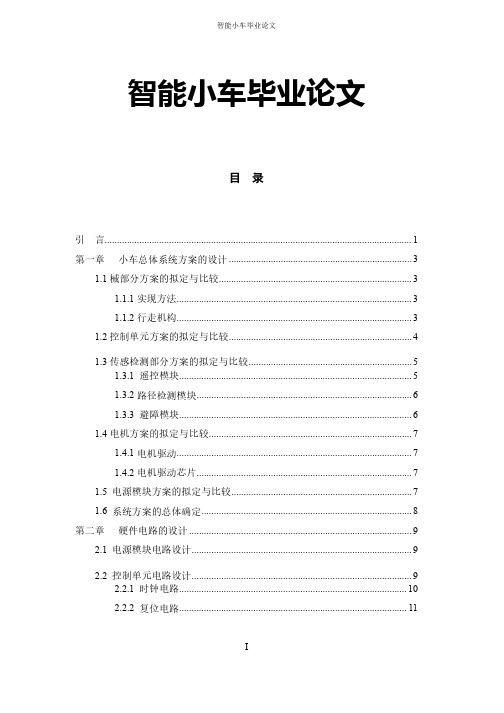
智能小车毕业论文智能小车毕业论文目录引言............................................................................................................................ 1第一章小车总体系统方案的设计.......................................................................... 31.1械部分方案的拟定与比较.............................................................................. 31.1.1实现方法............................................................................................... 31.1.2行走机构............................................................................................... 31.2控制单元方案的拟定与比较.......................................................................... 41.3传感检测部分方案的拟定与比较.................................................................. 51.3.1 遥控模块.............................................................................................. 51.3.2路径检测模块....................................................................................... 61.3.3 避障模块.............................................................................................. 61.4电机方案的拟定与比较.................................................................................. 71.4.1电机驱动............................................................................................... 71.4.2电机驱动芯片....................................................................................... 71.5 电源模块方案的拟定与比较......................................................................... 71.6 系统方案的总体确定..................................................................................... 8第二章硬件电路的设计.......................................................................................... 92.1 电源模块电路设计......................................................................................... 92.2 控制单元电路设计......................................................................................... 92.2.1 时钟电路............................................................................................ 102.2.2 复位电路............................................................................................ 11I 2.2.3 并口下载线电路................................................................................ 122.3 电机驱动电路............................................................................................... 132.4 红外遥控电路............................................................................................... 162.4.1 发射部分............................................................................................ 162.4.2 接收部分............................................................................................ 172.5 路经检测电路............................................................................................... 182.6 避障电路....................................................................................................... 19系统软件设计 ............................................................................................ 20第三章系统软件设计3.1 模糊控制算法............................................................................................... 203.1.1 模糊理论的发展................................................................................ 203.1.2 模糊控制算法原理............................................................................ 203.2 智能小车的模糊控制算法........................................................................... 213.2.1 模糊化................................................................................................ 213.2.2 模糊规则库的建立............................................................................ 223.3 编程软件Keil C51简介简介 .............................................................................. 233.4软件设计........................................................................................................ 243.4.1 软件设计思路.................................................................................... 243.4.2 各模块流程图和程序设计................................................................ 25软硬件系统调试 ........................................................................................ 34第四章软硬件系统调试4.1 路径检测调试场景....................................................................................... 344.2 调试结果....................................................................................................... 344.3 结果分析....................................................................................................... 35参考文献...................................................................................................................... 36辞谢.......................................................................................................................... 37附录.......................................................................................................................... 38引 言随着控制技术、计算机技术、信息处理技术和传感器检测技术以及汽车工业的飞速发展,智能小车在工业生产和日常生活中已经扮演了非常重要的角色,近年来,智能车在野外、道路、现代物流及柔性制造系统中都有广泛应用,已成为人工智能领域研究和发展的热点之一。
自动搬运小车的设计

摘要智能作为现代的新发明,他可以按照预先设定的模式自动的运行,不需要人的参与。
自动小车就是其中的一个体现,本系统就是以小车自动搬运为目的进行研究的。
在这个系统中,使用铁片来模拟货物。
自动小车主要实现小车的自动循迹及定点取物,卸物功能,同时执行计数计时功能。
系统主要采用AT89C51单片机为控制核心,利用红外传感器检测道路,把感应到的信号送给单片机,使小车沿固定轨迹自动行驶,到达要求地点后使用电感式接近开关检测铁片,并用电磁铁实现自动取物,并在此过程中可以自动记录时间、个数。
整个系统的电路结构简单,可靠性能高。
通过不断调试,系统实现结果满足要求,本文着重介绍了该系统硬件设计方法及功能的实现。
关键词: AT89C51单片机;小车;智能;搬运IAbstractThe invention of modern intelligent as he can, according to the predetermined pattern automatic operation, don't need anyone's participation. Intelligent vehicle is one of this system is to reflect, for the purpose of carrying automatic car research. Smart cars mainly realizes the automatic car tracing and follow the fetch things, dot, and count timer function. System mainly USES AT89C51 as control core, using infrared sensor, the induction of road to the microcontroller, signal to drive along the path, fixed location requirements after use inductive proximity switch detection, and the realization of automatic electromagnet iron, and take in this process can automatically record time, number. The whole system of the circuit structure is simple, reliable performance. Through constant adjustment, experimental implementation result meet the requirements, the paper introduces the hardware design method and function.Keywords:AT89C51; Dolly;Wisdom; handlingII目录1 绪论 (1)1.1 课题研究的目的和意义 (1)1.2 设计任务与要求 (3)1.3 本文内容安排 (3)2 方案论证 (4)2.1 系统工作 (4)2.2 方案设计 (4)3 硬件设计 (7)3.1 元器件选择 (7)3.1.1 核心控制单元电路的选择 (7)3.1.2 传感器的选择 (11)3.1.3 铁片检测及拾取的器件选择 (12)3.1.4 车体及驱动电路选择 (12)3.1.5 显示器件的选择 (14)3.2 各单元电路设计 (15)3.2.1 传感器及调理电路的设计 (15)3.2.2 小车运行位置确定电路的设计 (17)3.2.3 电机驱动电路的设计 (17)3.2.4 铁片检测及取物电路设计 (19)3.2.5 显示电路的设计 (20)3.2.6 复位电路及晶振电路 (21)4 软件设计 (23)4.1 循迹子程序 (23)4.2 小车位置确定及物体搬运 (25)4.3 显示子程序 (26)4.4 计数/计时子程序 (27)III5 设计调试 (28)5.1 软件调试 (28)5.2 硬件调试 (29)5.3 软硬件联调 (29)结论 (31)经济效益分析 (32)致谢 (33)参考文献 (34)附录Ⅰ电路原理图 (35)附录Ⅱ程序清单 (36)附录Ⅲ硬件实物图 (40)IV1绪论1.1课题研究的目的和意义智能作为现代社会的新发明,是以后的发展方向。
智能搬运小车..

本科生毕业设计(论文)智能搬运小车The Subject of Graduation Project学生姓名专业光信息科学与技术学号指导教师分院光电科学2014年 6月摘要本设计采用STC12C5A60S2单片机为简易智能小车的核心器件。
循迹模块由4对红外收发管组成,通过反射红外线的变化判断黑线的有无以达到循迹的功能,电机驱动模块选用 H 桥驱动芯片L298N 结合单片机来控制电机工作。
避障模块由两对红外发光管组成。
搬运模块通过TCS230识别不同颜色来分辨抓取和释放,从而达到搬运的目的。
整个系统的电路结构简单,可靠性能高,能满足设计的要求。
与传统搬运车相比,该车不耗费人力,不会造成人员的浪费且工作效率较高。
智能机器准确性较高,可以减少失误的发生,在未来工厂车间中,可以用智能搬运车来代替传统搬运车。
本文详细的阐述了整个智能搬运小车设计和制作以及最后测试的过程。
以最简洁最最有效的方法制作出了一个具有简单功能的小车。
关键词:智能循迹小车 STC12C5A60S2 红外收发管电机驱动TCS230ABSTRACTThe design adopts STC12C5A60S2 microcontroller as the core device of simple smart car. The tracking module is composed of a plurality of Photo electric tube, by reflecting infrared changes in judgments of black have to achieve the tracking function, motor drive module selection of commonly used H bridge driver L298N with single- chip microcomputer to control the motor working. Obstacle avoidance module consists of two pairs of infrared light emitting tube. Handling module TCS230 identify the different colors to distinguish grab and release, so as to achieve the purpose of handling. The electric circuit construction of whole system is simple, reliable performance. It can meet a variety of design requirements. Compared with conventional truck, the car is not labor intensive, no waste and higher staff efficiency. Intelligent machine high accuracy, can reduce the incidence of errors in the future on the factory floor, you can use smart truck to replace the traditional truck. This paper describes in detail the design and production of intelligent handling car and the final test of the entire process. In the most simple and effective way to make the most out of the car with a simple function.Keywords: Intelligent Tracking Car STC12C5A60S2 Infrared Receiving Tube Motor Drive TCS230目录摘要 ........................................................................................................................ - 1 -ABSTRACT........................................................................................................... - 3 -第1章绪论 . (1)1.1 研究目的及意义 (2)1.2 国内外发展情况 (2)第2章整体设计框架 (6)2.1 方案选择及论证 (6)2.1.1 控制模块选择 (6)2.1.2 路面探测黑线轨迹模块 (6)2.1.3 探测路面障碍模块 (7)2.1.4 电机模块 (8)2.1.5 电机驱动模块 (8)2.1.6 车架选择 (9)2.1.7搬运模块 (9)2.1.8仓库识别模块 (9)2.1.9 最终方案选择 (10)2.2 方案可行性分析 (10)第3章硬件设计 (12)3.1 系统总体设计框图 (12)3.2 红外线光电开关模块 (12)3.2.1 光电开关的工作原理 (13)3.2.2 光电开关的类型 (14)3.2.3 壁障光电管电路的设计 (16)3.3 电机驱动模块 (16)3.4 红外循线模块 (18)3.4.1 红外放射式光电传感器特性与工作原理 (18)3.5 红外循线具体设计与实现 (19)3.6金属探测模块 (20)3.7颜色识别模块 (21)1 .TCS230芯片的结构框图与特点 (21)2 .TCS230识别颜色的原理 (23)3.8 最小系统模块 (25)3.8.1 晶振电路的设计 (25)3.8.2 复位电路的设计 (26)3.9 电源模块 (27)第4章软件设计 (28)4.1 主程序流程图 (28)4.2 避障子程序流程图 (29)4.3 循线子程序流程图 (30)4.4搬运子程序流程图 (32)第5章系统调试和测试 (33)5.1 安装步骤 (33)5.2 电路调试 (33)5.2.1 光电开关模块调试过程 (33)5.2.2 电机模块调试过程 (34)5.2.3 红外循线模块调试过程 (34)5.2.4 测试结果与分析 (35)1.测试方法 (35)2.测试结果 (35)第六章结论 (36)致谢 (37)参考文献 (38)附录设计系统部分源代码 (39)绪论随着生产自动化的发展,机器人已经越来越广泛地应用到生产自动化上,随着科学技术的发展,机器人的感觉传感器种类越来越多,其中视觉传感器成为自动行走和驾驶的重要部件。
(完整word)自动搬运小车的研究
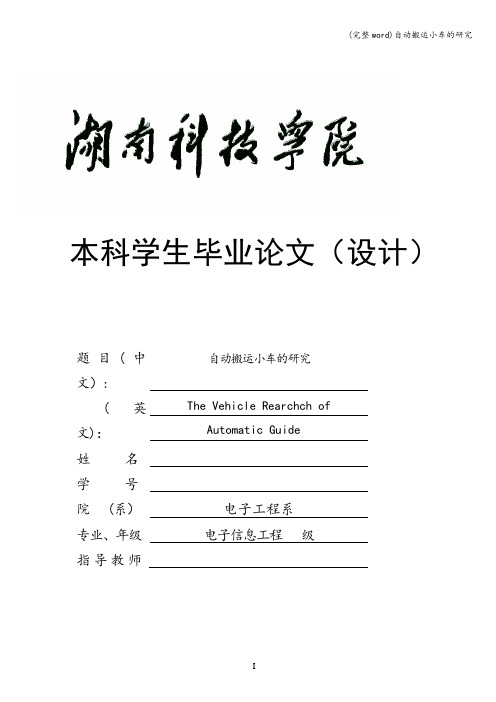
本科学生毕业论文(设计)题目(中文):自动搬运小车的研究(英文):The Vehicle Rearchch of Automatic Guide姓名学号院 (系)电子工程系专业、年级电子信息工程级指导教师湖南科技学院本科毕业论文(设计)诚信声明本人郑重声明:所呈交的本科毕业论文(设计),是本人在指导老师的指导下,独立进行研究工作所取得的成果,成果不存在知识产权争议,除文中已经注明引用的内容外,本论文不含任何其他个人或集体已经发表或撰写过的作品成果.对本文的研究做出重要贡献的个人和集体均已在文中以明确方式标明。
本人完全意识到本声明的法律结果由本人承担.本科毕业论文(设计)作者签名:二○年月日毕业论文(设计)任务书课题名自动搬运小车的研究称:学生姓名:电子工程系系别:专电子信息工程业:指导教师:湖南科技学院本科毕业论文(设计)任务书注:本任务书一式三份,由指导教师填写,经教研室审批后一份下达给学生,一份交指导教师,一份留系里存档。
(完整word)自动搬运小车的研究湖南科技学院毕业论文(设计)中期检查表注:此表用于指导教师在学生毕业论文(设计)初稿完成后对学生执行任务书情况进行中期检查时用,由指导教师填写。
湖南科技学院毕业设计(论文)指导过程记录表目录1 绪论 (I)1.1 课题的研究意义、现状和发展趋势 (3)1.2 设计目的 (4)1.3 系统的设计任务与要求 (4)1。
4 设计方法 (5)2 模糊PID控制原理 (6)2.1 模糊PID参数控制原理 (6)2.2 输入值的模糊化 (7)2.3 模糊规则控制表的建立 (7)3 系统总体框架设计 (10)3.1 方案选择与论证 (10)3.2 系统总体设计 (11)4 硬件系统的设计 (13)4。
1 主控模块介绍 (13)4.2 线路引导模块电路设计与实现 (13)4。
3 光源产生电路的设计与实现 (15)4。
4 声音产生电路的设计与实现 (16)4.5 电机驱动电路的设计与实现 (17)5 软件系统的设计 (19)5.1 搬运小车主程序设计及流程图 (19)5.2 模糊PID控制程序设计及流程图 (19)6 安装调试与测试分析 (22)6.1 测试仪器 (22)6.2 测试方法、步骤、注意事项 (22)6。
轮式全向移动小车体系结构综述开题报告范文-图文

轮式全向移动小车体系结构综述开题报告范文-图文本科毕业设计(论文)开题报告(含论文综述)学院:某某某某某某某工程学院所属教研室:某某某某某教研室课题名称:轮式全向移动小车体系结构综述专业(方向):某某某某某某某某某某某某某某班级:某某某班学号:某某某某某某某某某某某学生:某某某某某某指导教师:某某某某某某开题日期:2022年2月25日一、毕业设计(论文)选题的目的和意义。
[⑴课题名称;⑵有关的研究方向的历史、现状和发展情况分析;⑶前人在本选题研究领域中的工作成果简述]1、课题名称轮式全向移动小车体系结构综述2、有关的研究方向的历史、现状和发展情况分析随着电子通信与机电控制等技术的高速发展,人们已经开始并不断的尝试将智能小车或机器人以及高效率的工具引入我们工业的各个领域。
许多机、电、计算机一体化的新产品诞生。
现在,作为移动小车而开发的移动机构种类已相当繁多,仅就地面移动而言,移动机构就有车轮式、履带式、腿脚式、躯干式等多种形式。
适应了各种工作环境的不同要求,但车轮式移动机构显得尤其突出,逐渐成为全向移动小车的重要组成部分之一。
对于普通的轮式移动机构,转弯都需要一定的旋转半径,在狭小的空间常因无法横向移动而失去作用,这在一定程度上就限制了轮式小车的使用。
移动小车中的全方位轮式移动小车无需车体做出任何转动便可实现任意方向的移动,并且可以原地旋转任意角度,运动非常灵活,可沿平面上任意连续轨迹走到要求的位置,成为移动机构中的发展趋势。
由于轮式全方位轮移动机构移动灵活方便,故其具有一般的轮式移动机构所无法取代的独特特性。
在此,本设计根据国际上流行的麦克纳姆(Mecanum)轮设计方法,整理当前主流轮式全向移动小车的体系结构(机械、硬件、软件)与应用现状,现国内私家车的数量已经破亿,提出适用于车底安全检查应用的小型小车体系结并论证此体系结构有效性是迫在眉睫。
研究表明麦克纳姆轮全向移动机构的运动及转位灵活且不受限于运动空间,应用前景非常广阔。
毕业论文《自动循迹小车》
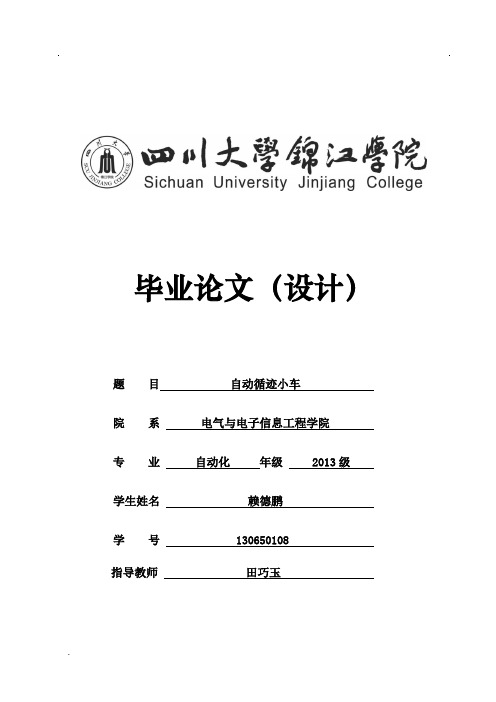
.毕业论文(设计)题目自动循迹小车院系电气与电子信息工程学院专业自动化年级 2013级学生姓名赖德鹏学号 130650108田巧玉自动循迹小车专业自动化学生赖德鹏指导教师田巧玉【摘要】本设计以LDC1000传感器探测金属为基础,以单片机控制技术为核心,实现小车自动探测金属轨道并正常行驶。
同时加入前进距离和时间的记录,用户可通过单片机STC15F2K60S2控制传感器根据不同的金属轨道进行参数矫正。
小车使用了L298N电机驱动以便于小车可以不通的速度匀速稳定的前进,最终实现集金属探测,实地矫正,参数的设定与数据显示于一身的智能循迹小车。
此设计有体积小,功耗低,适用范围广,用户操作界面设计人性化等特点。
【关键词】金属探测参数可调多功能显示智能控制Automatic Vehicle Tracking【Abstract】This design is based on the LDC1000 sensor to detect the metal, with the single-chip microcomputer control technology as the core, to realize the automatic detection of the metal track and normal driving. At the same time to join the advance distance and time records, the user can be controlled by a single chip microcomputer STC15F2K60S2 sensor based on different metal track parameters. The car uses a L298N motor drive for the car can get stable speed constant progress, and ultimately set the metal detection, field correction, intelligent vehicle tracking and data set parameters are displayed in a. This design has the characteristics of small size, low power consumption, wide application range, user-friendly design of user interface, and so on.【Key words】Metal detection adjustable parameters multifunction display intelligent control目录绪论........................................................ 错误!未定义书签。
自动移动送料小车设计论文
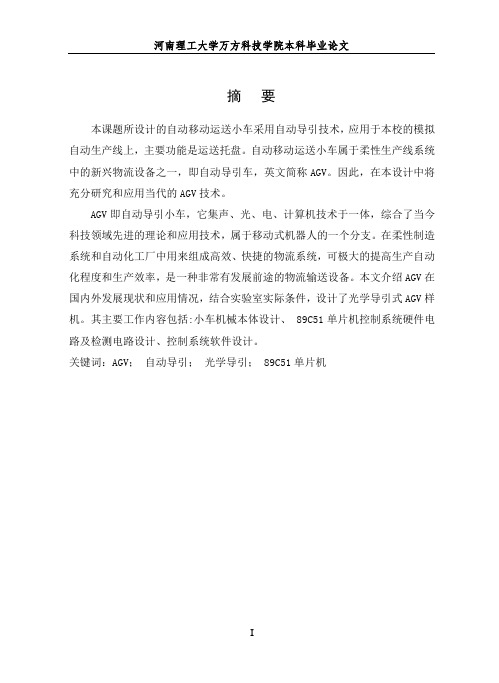
摘要本课题所设计的自动移动运送小车采用自动导引技术,应用于本校的模拟自动生产线上,主要功能是运送托盘。
自动移动运送小车属于柔性生产线系统中的新兴物流设备之一,即自动导引车,英文简称AGV。
因此,在本设计中将充分研究和应用当代的AGV技术。
AGV即自动导引小车,它集声、光、电、计算机技术于一体,综合了当今科技领域先进的理论和应用技术,属于移动式机器人的一个分支。
在柔性制造系统和自动化工厂中用来组成高效、快捷的物流系统,可极大的提高生产自动化程度和生产效率,是一种非常有发展前途的物流输送设备。
本文介绍AGV在国内外发展现状和应用情况,结合实验室实际条件,设计了光学导引式AGV样机。
其主要工作内容包括:小车机械本体设计、 89C51单片机控制系统硬件电路及检测电路设计、控制系统软件设计。
关键词:AGV;自动导引;光学导引; 89C51单片机AbstractThis topic is designed to automatically move the delivery of Automated Guided Vehicles using the technology for the simulation of our automatic production line, the main function is the delivery tray. Auto-mobile delivery of flexible production line car belonging to the emerging system of logistics equipment, that is, automated guided vehicle, the English referred to as AGV. Therefore, the design will be fully in the research and application of contemporary AGV technology.Automatic Guided Vehicle (AGV) covers the technologies of Optics, Electronics technologies Acoustics and Computer Science and other advanced theories and in the current scientific and technical fields, and it is one of the offshoots of mobile robot. AGV can greatly improve the degree of automatism and the efficiency of production when it is used to build an effective and speedy system of logistics in the flexible manufacturing system and automatic factory, and is a promising vehicle for the transportation of logistics.The paper studies the applications and developments of ALJV at home and abroad, and designs a laser guided AGV under actual conditions of the lab. The main work of the paper is as follows. The mechanical design of AIJV, the design of control system of hardware circuit and software based on 89C51 SCM.Key works: AGV; automatic guide; laser guide; AT89C51 SCM目录摘要 (I)ABSTRACT (1)目录 (I)1 绪论 (1)1.1 课题背景及研究意义 (1)1.2自动移动送料小车的关键技术——AGV发展现状 (2)1.2.1 国外AGV发展的历史及现状 (3)1.2.2 国内AGV发展的历史及现状 (5)1.3论文完成的主要工作 (6)2 自动移动送料小车AGV技术分析 (7)2.1AGV的类型 (7)2.2AGV的特点 (8)2.3AGV的导引方式 (9)2.3.1 导引方式分类 (10)2.3.2 AGV典型的导引方法 (10)2.4AGV系统的技术组成及调度方法 (14)2.4.1 AGV的技术组成 (14)2.4.2 AGV的调度方法 (16)3 自动移动送料小车总体结构 (18)3.1AGV技术指标及运行 (18)3.2总体结构设计方案 (18)3.3行走系统 (21)3.3.1 行走系统方案设计 (21)3.3.2 行走系统的技术设计 (22)3.4移载系统 (26)3.4.1 移载系统的方案设计 (26)3.4.2 移载系统技术设计 (27)3.5自动移动送料小车的导引方案 (29)4 AGV驱动控制系统电路设计 (32)4.1外围电路 (32)4.2传感器检测电路 (34)4.2.1 固定轨迹检测传感器 (34)4. 2. 2 障碍检测传感器 (35)5 控制系统软件设计 (36)结论 (40)致谢 (41)参考文献 (42)1 绪论1.1 课题背景及研究意义随着工厂自动化、计算机集成制造系统、柔性制造系统、现代物流、自动化立体仓库等系统的快速发展和广泛应用,自动移动送料小车作为AGV(英文Automatic Guided Vehicle 的缩写)的一种,即自动导引车。
自动移动送料小车设计论文
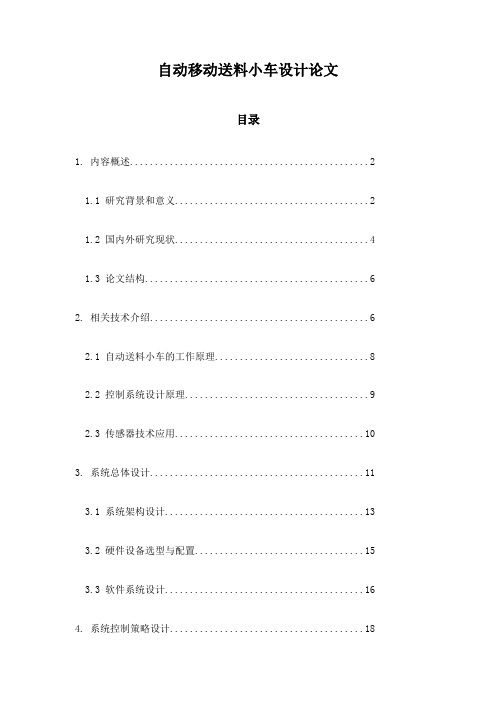
自动移动送料小车设计论文目录1. 内容概述 (2)1.1 研究背景和意义 (2)1.2 国内外研究现状 (4)1.3 论文结构 (6)2. 相关技术介绍 (6)2.1 自动送料小车的工作原理 (8)2.2 控制系统设计原理 (9)2.3 传感器技术应用 (10)3. 系统总体设计 (11)3.1 系统架构设计 (13)3.2 硬件设备选型与配置 (15)3.3 软件系统设计 (16)4. 系统控制策略设计 (18)4.1 运动控制策略设计 (19)4.2 定位控制策略设计 (20)4.3 速度控制策略设计 (21)5. 系统测试与验证 (23)5.1 系统硬件测试与验证 (24)5.2 系统软件测试与验证 (25)6. 结果分析与讨论 (26)6.1 结果分析 (28)6.2 讨论与改进 (29)7. 总结与展望 (30)7.1 研究成果总结 (32)7.2 工作不足与展望 (33)1. 内容概述本文旨在设计一种自动移动送料小车,以解决工业生产线中人工送料繁琐、效率低下的问题。
该小车将采用自主导航技术,通过环境感知和路径规划实现无人化送料流程。
涵盖的设计内容包括:小车机械结构设计:讨论小车框架结构、驱动系统、载物平台和避障系统的设计方案,并分析其性能指标和结构特点。
物料感知和处理:探讨利用传感器感知物料状态,并设计相应的抓取、搬运和释放机制。
控制系统及通讯方案:分析小车控制系统的架构,包括硬件平台选择、软件算法设计以及与生产线其他设备的通讯接口。
安全性分析及解决方案:评估小车运行过程中的安全风险,并提出相应的安全防护措施,例如紧急停止机制、安全区域划分和碰撞检测。
将对设计方案进行仿真验证,并进行小规模试制和测试,验证小车的性能和可靠性。
1.1 研究背景和意义在现代制造业中,自动化和智能化已经成为提升效率和降低成本的关键因素。
随着工业概念的深入发展,制造业正逐步向数字化、网络化和智能化转型。
送料作业作为制造业生产链中不可或缺的一环,主要负责物料的搬运与输送,并对生产节拍和质量稳定性发挥着重要作用。
- 1、下载文档前请自行甄别文档内容的完整性,平台不提供额外的编辑、内容补充、找答案等附加服务。
- 2、"仅部分预览"的文档,不可在线预览部分如存在完整性等问题,可反馈申请退款(可完整预览的文档不适用该条件!)。
- 3、如文档侵犯您的权益,请联系客服反馈,我们会尽快为您处理(人工客服工作时间:9:00-18:30)。
摘要作为移动小车而开发的移动机构种类已相当繁多,仅就地面移动而言,移动机构就有车轮式、履带式、腿脚式、躯干式等多种形式,适应了各种工作环境的不同要求。
全向移动小车的全方位轮具有平面内三个自由度,可同时独立的前后、左右和原地旋转运动,可在不改变自身位姿的情况下向任意方向移动。
借助于横向移动和原地回旋的特性,全方位运动平台还可方便的穿梭于狭窄拥挤空间中,灵活完成各种任务,相比传统移动平台有明显优势。
本综述论文首先分析了全向移动小车在国内外的研究简史与应用现状;对现使用较为广泛的全向轮进行综述对比;重点对当前主流轮式全向移动小车按照其机械结构、硬件模块、软件分析进行分类整理,总结论述了全向移动小车的三种控制方式;最后对全文进行归纳总结,展望了轮式全向移动小车的发展方向。
本综述论文在借鉴国内外的研究成果上,较为完善的总结了全向移动小车体系结构,为以后深入研究轮式全向移动平台的广泛应用提供理论参考依据。
关键字:麦克纳姆轮;全方位移动小车;车底安全检查Review of wheeled omni-directional mobile vehicle architecture Student:CHEN Feng-jun Teacher:XU Jian-yuAbstract:As the development of moving mobile car types of institutions has been quite extensive, only the ground moving, the moving mechanism had wheels, crawler, legs, torso and so on, adapted to the different requirements of various work environments.Moved car full omni-directional wheel having a plane of the three degrees of freedom, which can separate front, left, and rotational movement in situ, can be made without changing their posture in the case move in any direction. In situ by means of maneuver and lateral movement characteristics, full-motion platform can be easily shuttle in the narrow, flexible, complete a variety of tasks, compared to traditional mobile platform has obvious advantages.This review analyzes the omni-directional mobile car at home and abroad Brief History of Research and Application Status; right now the more widely used omni-directional wheel summarized comparison; focusing on the current mainstream wheeled omni-directional mobile car according to its mechanical structure, hardware modules , software analysis carry out classify collate, summarize discusses the omni-directional mobile trolley's three kinds control mode; Finally pairs of full-text carry on summarized, prospected wheeled omni-directional mobile car direction of development.This review paper drawing on the research results at home and abroad, the more perfect summary of the whole architecture of the mobile car for future in-depth study wheeled omni-directional mobile platform widely used to lay a good foundation.Keywords: Mecanum wheel; omni-directional mobile robot; vehicle safety inspection目次摘要 (I)Abstract................................................................................................. 错误!未定义书签。
1 引言 (1)1.1 课题研究的背景和意义 (1)1.2 课题研究的主要内容和工作 (1)2 全向移动小车研究简史与应用现状 (2)2.1 国外研究 (2)2.2 国内研究 (2)2.3 应用现状 (3)2.4 本章小结 (5)3 轮式全向轮的研究综述 (6)3.1 正交轮系 (6)3.2 Rover轮系 (6)3.3 球轮系 (6)3.4 Mutual YoYo轮系 (6)3.5 偏心轮系 (7)3.6 Mecanum轮系 (7)3.7 本章小结 (8)4 主流轮式全向移动小车体系结构 (8)4.1 机械结构 (9)4.1.1三轮结构 (9)4.1.2四轮结构 (9)4.1.3两者比较 (10)4.2 硬件控制模块 (11)4.2.1主控制器模块 (11)4.2.2传感器模块 (13)4.2.3次硬件模块 (13)4.3 软件分析 (14)4.3.1单片机软件分析 (14)4.3.2DSP软件分析 (14)4.4 三种控制方式 (15)4.4.1全向自主模式 (16)4.4.2全向循迹模式 (18)4.4.3遥控传感模式 (18)4.4.4各控制模式综合 (19)4.5 本章小结 (19)5 轮式全向移动小车结论与展望 (19)5.1 结论 (19)5.2 展望 (20)5.2.1车底安全检查 (20)5.2.2航天器制造业 (20)5.2.3高空作业平台 (20)5.2.4空间重负荷平台 (21)致谢 (21)参考文献 (22)附录 (24)1 引言1.1 课题研究的背景和意义随着电子通信与机电控制等技术的高速发展,人们已经开始并不断的尝试将智能小车或机器人等高效率的工具引入我们工业的各个领域。
现在,作为移动小车而开发的移动机构已相当繁多,仅就地面移动而言,移动机构就有车轮式、履带式、腿脚式、躯干式等多种形式,适应各种工作环境要求。
车轮式移动机构尤其突出,逐渐成为移动小车的重要组成部分之一。
对于普通的轮式移动机构,转弯都需要一定的旋转半径,在狭小的空间常因无法横向移动而失去作用,这在一定程度上限制了轮式移动小车的使用范围。
而轮式全向移动小车的车体无需做出任何转动,便可实现前后、左右和自转3个自由度运动,成为轮式移动机构的主要发展趋势。
全向移动小车以Mecanum 全方位轮(Omni- directional wheel)研究最多。
全方位移动小车就轮结构布局而言,以结构支撑稳定可靠、各轮负载较均匀、运动平稳、易于控制等优点的四轮结构在实际应用最为广泛。
研究表明麦克纳姆轮全向移动小车在运动及转位方面灵活,不受运动空间空间,可应用于生活、物流、工业和机器人等多个领域,有广阔的应用前景。
1.2 课题研究的主要内容和工作本课题研究内容主要有:整理当前主流轮式全向移动小车的体系结构(机械、硬件、软件)与应用现状。
主要工作如下:1)根据轮式全向移动小车体系结构,整理出当前轮式全向移动小车体系结构的机械、硬件、软件和移动小车的应用现状。
2)参照国内外已有实例,提出适用于车底安全检查应用的小型小车体系结并论证此体系结构有效性。
3)搜集国内/外文献,整理此领域1980年代以来研究简史。
4)简单预测本领域未来的研究发展方向。
5)查找本领域的主要研究机构及其研究子领域内容和研究现状;本领域主要国际期刊及其关注的子领域内容;本领域主要国际会议的网址、提交会议论文方式。
2 全向移动小车研究简史与应用现状目前移动机构的使用最广泛且最可靠的就算轮式移动小车了。
相对于目前亦有应用的其他移动形式(履带式、蛇行式、腿足式等)而言,移动小车运动效率高、载重能力强、机械结构稳定等优点可满足大部分工业环境使用要求。
且小车的结构丰富、驱动控制相对简单、运动灵活、行进速度相对较高而倍受青睐[1-4]。
因此,国内外相关研究机构对此作出广泛的研究。
2.1 国外研究对于全方位移动机器人的研究工作,国外已有相当多的研究机构进行了广泛的研究,全方位移动机器人大致可以分为6类,美国、德国、日本等发达国家在此领域上属于领先地位(具体分析参见第三章)。
2.2 国内研究我国自上个世纪八十年代,才开始对Mecanum轮的研究工作。
研究主要集中在Mecanum轮结构与机理分析上,主要研究机构包括清华大学、国防科技大学、浙江大学、中国科学院等高等院校和国家科研机构。
上海大学研制的全方位越障爬壁机器人可以在保持姿势不变的情况下,沿壁面进行全方位移动,并能跨越运行路径中的障碍物。
该机构结构简单,不需要传感装置来检测障碍。
江南大学的高春能,纪志成研制一种定制使用单排万向行走轮的新型全方位移动机器人,见图2-1。
付宜利、王树国等进行了全方位轮式移动机器人平台研究,提出了一种新型轮式移动机器人结构,见图2-2。
图2-1单排万向行走轮图2-2 全方位轮式移动机器人浙江大学张翮、熊蓉、褚健[5]和哈尔滨工业大学的闫国荣,张海兵各研究一种在结构复杂程度、承载能力和效率方面都有所改进的新型全方位轮式移动机构,即双排万向行走轮[6],见图2-3。
图2-3双排万向行走轮与全方位移动足球机器人北京中国科学院自动化研究所研制的全方位移动机械手,该全方位移动机械手主要由3 个轮间夹角互为120°的偏心方向轮构成。
